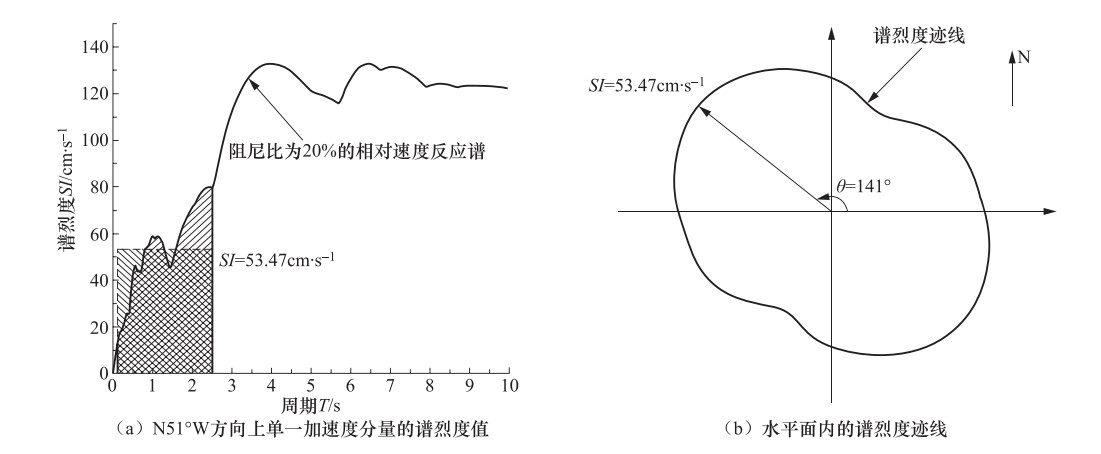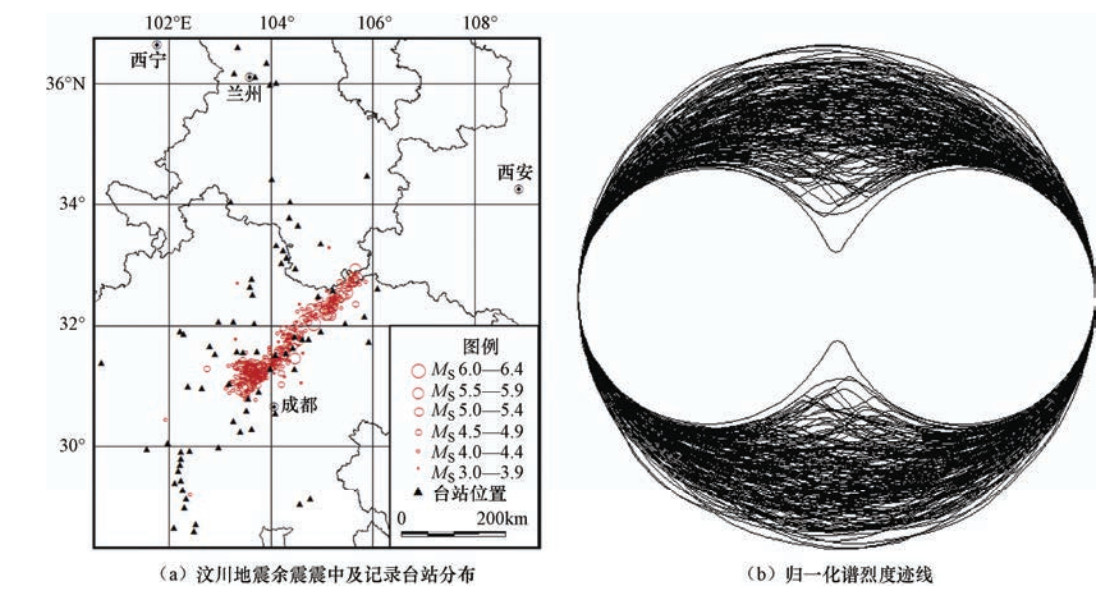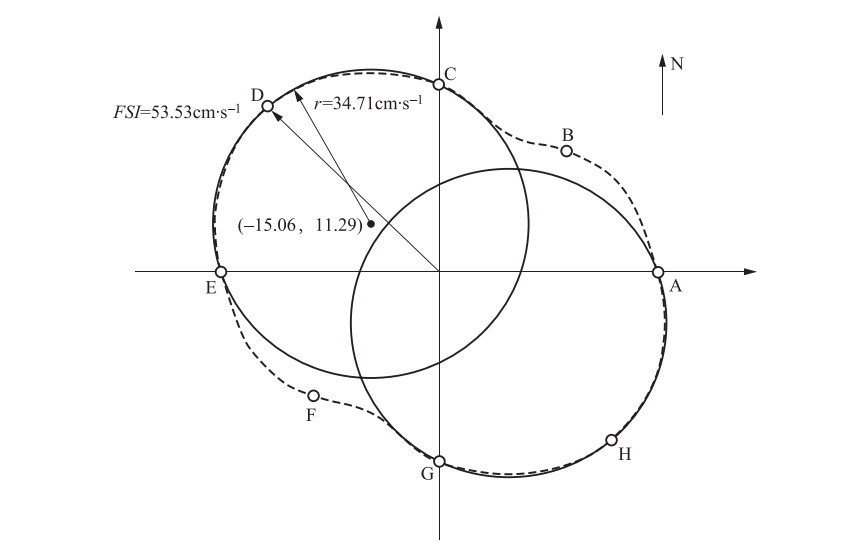A Fast Approximation Algorithm for Housner's Spectral Intensity
-
摘要: Housner谱烈度及修正谱烈度作为基于加速度记录时程直接得到的地震动强度参数,与建筑结构破坏及地震宏观烈度存在较高的相关性,是可靠的地震仪器烈度物理参数指标。然而,相对于地面加速度峰值、地面速度峰值等地震动峰值参数,三分量加速度记录对应的谱烈度计算过程较为复杂,耗时相对较长,影响了利用谱烈度确定地震仪器烈度的时效性。基于对强震动加速度记录的统计分析,本文提出了谱烈度的快速近似算法,仅计算4个方向上的谱烈度值,采用其中3点作圆即可获得水平面内谱烈度迹线的近似最大值,使计算速度提高了45倍,且保持了谱烈度作为地震仪器烈度物理指标的精度。利用在汶川MS 8.0地震等386次MS > 3.0地震中获取的2701组强震动加速度记录,经可靠性检验,结果表明所提出的Housner谱烈度快速近似算法的计算误差在±4.5%以内,可以同时满足地震仪器烈度速报的可靠性和时效性需求。Abstract: As a parameter of ground motion strength derived directly from acceleration records, Housner's spectral intensity and its modified version are highly correlated to building destructure and seismic intensity, and has been adopted as a reliable metric of instrumental seismic intensity. But the algorithm for Housner spectum intensity of a three-component acceleration record was relatively complicated than that of peak ground motion parameter such as peak ground acceleration and peak ground velocity, and this defect of time consuming severely influences the timeliness in instrumental seismic intensity determination. Base on the analyses and ststistics of strong-motion acceleration records, a fast calculating algorithm for spectral intensity is proposed, which obtained the approximate value of the maximum spectral intensity value in the horizontal plane by circle fitting of three points among the spectral intensity values in 4 certain directions. The calculation speed of this algorithm is 45 times higher than that of former algorithms, and the precision accuracy of spectral intensity as a metric of instrumental seismic intensity does not decrease. The reliability testing using 2701 sets of acceleration records in 386 MS > 3.0 earthquakes including Wenchuan MS 8.0 eartuquake indicated that the relative error of this fast calculating algorithm is less than 4.5%, which can satisfied the needs of reliability and timeliness for the rapid report of seismic intensity.
-
表 1 算法可靠性验证所用强震动记录的数量统计
Table 1. Acceleration records used in reliability veritification of fast calculating algorithm for Housner spectum intensity
震级 PGA/cm·s-2 PGA<3 3≤PGA<10 10≤PGA<30 30≤PGA<100 100≤PGA<300 300≤PGA<500 PGA≥500 MS=8.0 64 135 132 64 44 6 5 MS=7.0 20 39 31 21 7 5 3 MS=6.5 26 31 11 3 2 1 6.0≤MS<6.5 21 84 76 29 7 5.5≤MS<6.0 29 103 65 40 8 1 5.0≤MS<5.5 36 201 89 31 6 4.5≤MS<5.0 74 270 119 27 3 4.0≤MS<4.5 96 296 145 30 7 3.0≤MS<4.0 18 84 43 13 -
崔建文, 刘琼仙, 段建新等, 2014.2014年云南鲁甸6.5级地震强震动观测记录及初步分析.地震研究, 37(4):542-548. doi: 10.3969/j.issn.1000-0666.2014.04.009 金星, 张红才, 李军等, 2013.地震仪器烈度标准初步研究.地球物理学进展, 28(5):2336-2351. http://d.old.wanfangdata.com.cn/Periodical/dqwlxjz201305016 赖敏, 朱建钢, 朱永莉, 2014.芦山地震数字强震动观测记录及其初步分析.四川地震, (2):6-11. http://d.old.wanfangdata.com.cn/Periodical/scdz201402002 李敏, 2010.地震动加速度反应谱与地震烈度的关系研究.哈尔滨:中国地震局工程力学研究所, 44-52. 李世成, 崔建文, 张潜等, 2011.2009年姚安6.0级地震强震动应急观测的数据处理及其震害启示.灾害学, 26(4):82-88. doi: 10.3969/j.issn.1000-811X.2011.04.016 李世成, 林国良, 崔建文等, 2013.宁蒗-盐源5.7级地震数字强震动台网记录及初步分析.地震研究, 36(4):502-507. doi: 10.3969/j.issn.1000-0666.2013.04.015 李山有, 金星, 陈先等, 2002.地震动强度与地震烈度速报研究.地震工程与工程振动, 22(6):1-7. doi: 10.3969/j.issn.1000-1301.2002.06.001 林淋, 孙景江, 2011.不同地震动参数与地震烈度相关性对比研究.地震工程与工程振动, 31(1):6-10. http://d.old.wanfangdata.com.cn/Periodical/dzgcygczd201101002 马强, 李水龙, 李山有等, 2014.不同地震动参数与地震烈度的相关性分析.地震工程与工程振动, 34(4):83-92. http://d.old.wanfangdata.com.cn/Conference/8421967 王玉石, 周正华, 王伟, 2008.基于假设检验的地震动强度(烈度)速报方法.地震工程与工程振动, 28(5):49-54. http://d.old.wanfangdata.com.cn/Periodical/dzgcygczd200805007 王玉石, 周正华, 兰日清, 2010.利用修正谱烈度确定我国西部地区仪器烈度的建议方法.应用基础与工程科学学报, 18(S1):119-129. http://www.wanfangdata.com.cn/details/detail.do?_type=perio&id=QK201001943620 王玉石, 李小军, 梅泽洪等, 2013.几种仪器烈度算法在汶川地震与芦山地震中的可靠性比较.地震学报, 35(5):759-770. doi: 10.3969/j.issn.0253-3782.2013.05.014 朱永莉, 黎大虎, 龙承厚等, 2015.不同仪器烈度算法在四川地区历次地震中的比较应用.地震学报, 37(2):355-346. doi: 10.3969/j.issn.1000-0844.2015.02.0355 Atkinson G. M., Kaka S. I., 2007. Relationships between felt intensity and instrumental ground motion in the Central United States and California. Bulletin of the Seismological Society of America, 97 (2):497-510. doi: 10.1785/0120060154 Boatwright J., Thywissen K., Seekins L. C., 2001. Correlation of ground motion and intensity for the 17 January 1994 Northridge, California, earthquake. Bulletin of the Seismological Society of America, 91 (4):739-752. doi: 10.1785/0119990049 Bradley B. A., 2009. Site-specific and spatially distributed ground-motion prediction of acceleration spectrum intensity. Bulletin of the Seismological Society of America, 100 (2):792-801. http://www.wanfangdata.com.cn/details/detail.do?_type=perio&id=4868394826820fe0e80a13b869a474f7 Bradley B. A., Cubrinovski M., Dhakal R. P., et al., 2009a. Intensity measures for the seismic response of pile foundations. Soil Dynamics and Earthquake Engineering, 29 (6):1046-1058. doi: 10.1016/j.soildyn.2008.12.002 Bradley B. A., Cubrinovski M., MacRae G. A., et al., 2009b. Ground-motion prediction equation for SI based on spectral acceleration equations. Bulletin of the Seismological Society of America, 99 (1):277-285. doi: 10.1785/0120080044 Bradley B. A., Dhakal R. P., MacRae G. A., et al., 2010a. Prediction of spatially distributed seismic demands in specific structures:ground motion and structural response. Earthquake Engineering and Structural Dynamics, 39(5):501-520. doi: 10.1002/eqe.954/full Bradley B. A., Dhakal R. P., MacRae G. A., et al., 2010b. Prediction of spatially distributed seismic demands in specific structures:structural response to loss estimation. Earthquake Engineering and Structural Dynamics, 39 (6):591-613. doi: 10.1002/eqe.955/full Bradley B. A., 2011. Empirical correlation of PGA, spectral accelerations and spectrum intensities from active shallow crustal earthquakes. Earthquake Engineering and Structural Dynamics, 40 (15):1707-1721. doi: 10.1002/eqe.v40.15 Chernov Y. K., Sokolov V. Y., 1999. Correlation of seismic intensity with Fourier acceleration spectra. Physics and Chemistry of the Earth, Part A:Solid Earth and Geodesy, 24 (6):523-528. doi: 10.1016/S1464-1895(99)00065-4 Fahjan Y. M., Alcik H., Sari A., 2011. Applications of cumulative absolute velocity to urban earthquake early warning systems. Journal of Seismology, 15 (2):355-373. doi: 10.1007/s10950-011-9229-8 Housner G. W., 1952. Spectrum intensities of strong-motion earthquakes. In: Proceedings of the Symposium on Earthquake and Blast Effects on Structures. Los Angeles, California: Earthquake Engineering Research Institute, 20-36. Iwata T., 1991. Earthquake sensing device by SI (spectrum intensity) value for system shut-down use. Journal of High Pressure Institute of Japan, 29 (3):137-144. http://www.wanfangdata.com.cn/details/detail.do?_type=perio&id=J-STAGE_531922 Karim K. R., Yamazaki F., 2001. Estimation of the JMA seismic intensity from liquefied records and its correlation with strong motion parameters. In: Proceedings of the 26th Japan Earthquake Engineering Symposium. Sapporo, Japan: J-STAGE, 253-256. Karim K. R., Yamazaki F., 2002. Correlation of JMA instrumental seismic intensity with strong motion parameters. Earthquake Engineering and Structural Dynamics, 31 (5):1191-1212. doi: 10.1002/(ISSN)1096-9845 Katayama T., Sato N., Ohbo N., et al., 1986. Ground shaking severity detector by use of spectrum intensity (SI). In: Proceedings of the 7th Japan Earthquake Engineering Symposium. Tokyo, Japan: J-STAGE, 7: 373-378. Koganemaru K., Shimizu Y., Nakayama W., et al., 2000. Development of a new SI sensor. In: Proceedings of the 12th World Conference of Earthquake Engeering. Auckland, New Zealand: WCEE. Linkimer L., 2008. Relationship between peak ground acceleration and modified Mercalli intensity in Costa Rica. Revista Geológica de América Central, 38:81-94. Margottini C., Molin D., Serva L., 1992. Intensity versus ground motion:a new approach using Italian data. Engineering Geology, 33 (1):45-58. doi: 10.1016/0013-7952(92)90034-V Martínez-Rueda J. E., 1998. Scaling procedure for natural accelerograms based on a system of spectrum intensity scales. Earthquake Spectra, 14 (1):135-152. doi: 10.1193/1.1585992 Nau J. M., Hall W. J., 1984. Scaling methods for earthquake response spectra. Journal of Structural Engineering, 110 (7):1533-1548. doi: 10.1061/(ASCE)0733-9445(1984)110:7(1533) Shabestari K. T., Yamazaki F., 2001. A proposal of instrumental seismic intensity scale compatible with MMI evaluated from three-component acceleration records. Earthquake Spectra, 17 (4):711-723. doi: 10.1193/1.1425814 Shimizu Y., Koganemaru K., Yamazaki F., et al., 2000. Seismic motion observed in Taipei basin by new SI sensors and its implication to seismic zoning. In: Proceedings of the 6th International Conference on Seismic Zonation. Palm Springs, California: Earthquake Engineering Research Institute, 497-502. Sokolov V. Y., Chernov Y. K., 1998. On the correlation of seismic intensity with Fourier amplitude spectra. Earthquake Spectra, 14 (4):679-694. doi: 10.1193/1.1586022 Sokolov V. Y., 2002. Seismic intensity and fourier acceleration spectra:revised relationship. Earthquake Spectra, 18 (1):161-187. doi: 10.1193/1.1469037 Takubo K., Yanada T., Furukawa H., et al., 1999. Innovative spectral intensity transducer using three-axial micromachining accelerometer for earthquake crisis management. In: Proceedings of the 7th IEEE International Conference on Emerging Technologies and Factory Automation. Barcelona, Spain: IEEE, 1: 379-384. https://www.researchgate.net/publication/3831381_Innovative_spectral_intensity_transducer_using_three-axial_micromachining_accelerometer_for_earthquake_crisis_management Trifunac M. D., Brady A. G., 1975. A Study on the duration of strong earthquake ground motion. Bulletin of the Seismological Society of America, 65 (3):581-626. http://www.wanfangdata.com.cn/details/detail.do?_type=perio&id=954aacfd06f585487542ce832a2bf632 Trifunac M. D., Westermo B., 1977. A note on the correlation of frequency-dependent duration of strong earthquake ground motion with the modified Mercalli intensity and the geologic conditions at the recording stations. Bulletin of the Seismological Society of America, 67 (3):917-927. Ueong Y. S., 2009. A study on feasibility of SI for identification of earthquake damages in Taiwan. Soil Dynamics and Earthquake Engineering, 29 (1):185-193. doi: 10.1016/j.soildyn.2007.12.005 Wald D. J., Quitoriano V., Heaton T. H., et al., 1999. Relationships between peak ground acceleration, peak ground velocity, and modified Mercalli intensity in California. Earthquake Spectra, 15 (3):557-564. doi: 10.1193/1.1586058 Wang Q., Fu J. H., Wang Z. Y., et al., 2012. A seismic intensity estimation method based on the fuzzy-norm theory. Soil Dynamics and Earthquake Engineering, 40:109-117. doi: 10.1016/j.soildyn.2012.03.010 Wang Y. S., Li X. J., Zhou Z. H., 2013. A new instrumental measure of epicentral shaking intensity in Western China. Bulletin of Earthquake Engineering, 11 (4):913-924. doi: 10.1007/s10518-013-9428-5 Wu Y. M., Teng T. L., Shin T. C., et al., 2003. Relationship between peak ground acceleration, peak ground velocity, and intensity in Taiwan. Bulletin of the Seismological Society of America, 93 (1):386-396. doi: 10.1785/0120020097 -




 下载:
下载:




